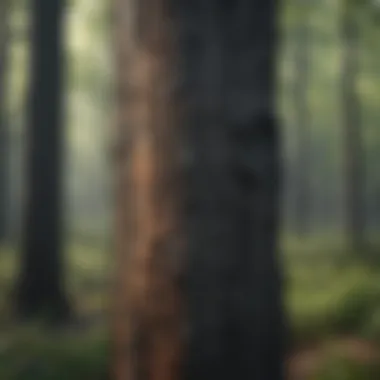The Science and Significance of Lightning Strikes


Intro
Understanding lightning strikes in woodlands is not just a scientific curiosity; it holds significant ecological implications. Lightning, a natural occurrence, affects forest health and biodiversity in multiple ways. Beyond mere spectacle, its impacts resonate throughout ecosystems, influencing management practices aimed at forest sustainability and conservation. This article seeks to provide a comprehensive exploration of these themes, examining the intersection between natural phenomena and ecological stewardship.
Understanding Woodland Ecosystems
Woodland ecosystems are complex networks that rely on various biotic and abiotic factors to function effectively. The balance within these systems contributes to overall biodiversity, which is paramount for a thriving environment.
Importance of Biodiversity in Forests
Biodiversity encompasses the variety of life forms in a given ecosystem. In the context of woodlands, it includes a multitude of tree species, fauna, fungi, and microorganisms. Each of these components plays a unique role:
- Nutrient Cycling: Diverse species enhance soil nutrition and promote healthy plant growth.
- Habitat Stability: A broader array of species contributes to ecosystem resilience, enabling it to withstand disturbances, such as fire or disease.
- Pollination and Seed Dispersal: Different organisms facilitate reproduction for numerous species, ensuring continued growth and diversity.
Role of Forests in Climate Regulation
Forests serve as critical components in regulating the global climate. They sequester carbon dioxide, releasing oxygen and contributing to cleaner air. Furthermore, forests influence local weather patterns, affecting rainfall distribution and temperature moderation. Their health is intertwined with climate stability, which in turn impacts human communities and wildlife alike.
Sustainable Forestry Practices
Sustainable forestry is essential for preserving woodland ecosystems while meeting human needs. This involves actively managing forest resources to maintain balance and promote ecological integrity.
Principles of Sustainable Forestry
Sustainable forestry prioritizes the ecological health of forests by integrating multiple principles:
- Minimal Impact Logging: This method reduces damage to surrounding trees and soil, promoting regeneration.
- Biodiversity Conservation: Protecting diverse species ensures resilient forest structures.
- Community Involvement: Engaging local communities in forest management leads to better practices that reflect their knowledge and needs.
Case Studies of Successful Implementations
Looking at real-world applications can highlight effective sustainable forestry. For instance, the Forest Stewardship Council has recognized several initiatives worldwide that promote sustainable harvesting. In Sweden, the management of boreal forests showcases how proper practices can lead to thriving ecosystems while still providing timber resources. Such examples illustrate the tangible benefits of sustainable approaches that can be replicated elsewhere.
Woodland Stewardship Techniques
Effective woodland stewardship involves comprehensive planning and actionable strategies to ensure forest health and functionality.
Forest Management Plans
A robust forest management plan is crucial in guiding stewardship efforts. It outlines specific actions to be taken, based on ecological assessments and stakeholder input. Key elements of a management plan include:
- Assessment of Forest Health: Regular surveys help identify issues needing attention.
- Management Objectives: Clear goals guide proactive measures that reflect conservation priorities.
- Monitoring Programs: Continuous evaluation ensures that practices remain effective over time.
Conservation Strategies
Protecting wooded areas requires a range of conservation strategies. These can include:
- Protected Areas: Establishing reserves can safeguard local ecosystems from industrial pressures.
- Reforestation Initiatives: Replanting native species restores balance to disturbed areas and enhances biodiversity.
"Engaging in thoughtful forest management practices fosters resilience against disturbances such as lightning, while promoting health and biodiversity within woodland ecosystems."
The connection between lightning strikes and forest ecosystems is complex. Understanding this dynamic leads to better management practices that reflect both the natural phenomena and the significance of forest health. Overall, the integration of scientific understanding with practical stewardship is essential for sustaining our invaluable woodland ecosystems.
Understanding Lightning: A Scientific Overview
Understanding lightning is crucial to appreciating its diverse impacts on woodland ecosystems. Lightning shapes not only the physical environment but also the ecological interactions within forests. Its significance extends from influencing plant health to affecting animal habitats. This section aims to distill the essence of lightning and provide a foundational understanding necessary for forestry professionals and academics alike.
What is Lightning?
Lightning is a natural electrical discharge that occurs during thunderstorms. It generally manifests as a bright flash and sounds as thunder. This phenomenon arises when a significant difference in electrical charge builds up in the atmosphere. The discharge can result from various weather conditions, primarily involving moist air that carries particles that create static electricity. The energy released during lightning strikes can be immense, often exceeding 1 billion volts.
The Physics of Lightning Formation
The formation of lightning is a complex process that begins with the separation of electrical charges within clouds. As storm clouds develop, ice particles collide, causing a transfer of electrons. This movement leads to a charge gradient, where the top of the cloud becomes positively charged and the bottom becomes negatively charged. When the potential difference is too great, a conductive path forms through the air, resulting in a discharge of energy we recognize as lightning.


The electrical discharge occurs in several stages:
- Stepped Leader: A conductive path descends from the cloud towards the ground.
- Return Stroke: Once the leader connects, a powerful flow of current travels back to the cloud, creating the bright flash typical of lightning.
- Subsequent Strokes: Additional discharges may follow the same path, enhancing the brightness and duration of the event.
Different Types of Lightning Events
Various types of lightning events exist, each with unique characteristics:
- Cloud-to-Ground Lightning: This is the most recognized type, where the discharge travels from the cloud directly to the Earth’s surface.
- Intra-Cloud Lightning: This occurs within a single cloud and is responsible for many flashes seen during a storm.
- Cloud-to-Cloud Lightning: This type involves electrical discharges between two separate clouds.
- Ground-to-Cloud Lightning: Less common, this occurs when electrical charge is sent from the ground upwards into the cloud.
Understanding these types of lightning is essential for predicting their impact on forested areas and initiating necessary safety measures.
By examining these aspects, forestry and ecological professionals can better grasp the formidable presence of lightning in woodland ecosystems, paving the way for informed discussions on its broader implications.
Patterns of Lightning Strikes in Woodlands
Understanding the patterns of lightning strikes in woodlands is essential for comprehending how these natural phenomena affect forest ecosystems. The frequency and distribution of lightning can influence various ecological processes, from plant diversity to soil composition. With proper analysis, we gain insights into the intricate interactions between lightning and forest health, ultimately enriching our management practices.
Geographical Distribution of Strikes
Lightning strikes vary significantly around the world, often correlated with geographic and climatic factors. Areas with high humidity and frequent thunderstorms typically experience more strikes. Regions such as the Southeastern United States are notable for their high lightning frequency compared to more temperate areas. Forest habitats in these heavily-struck regions showcase unique biodiversity and resilience strategies developed in response to regular lightning activity.
A study of lightning distributions shows that coastal regions might receive different strike patterns due to their proximity to oceans, which create specific weather systems. The orographic lift, caused by mountains, can also contribute to increased electrical activity. Thus, geographical characteristics play a crucial role in shaping the dynamics within woodland ecosystems.
Factors Influencing Lightning Frequency
Several factors influence how often lightning strikes occur in woodlands. Climate conditions are the most significant, particularly temperature, humidity, and atmospheric pressure. Warmer temperatures might encourage more thunderstorms. Additionally, human activities can alter local climates and potentially increase lightning frequencies. Urbanization, for example, impacts temperature and can lead to changes in rainfall patterns.
Vegetation type and density also matter when considering lightning vulnerability. Dense forests might experience more strikes as trees can act as natural conductors. Fire-prone regions demonstrate heightened risks, as dried timber and underbrush make for ideal lightning targets that can ignite fires. Understanding these influential elements is critical for forestry professionals aiming to mitigate risks in vulnerable woodlands.
Mapping Lightning Strike Trends
Tracking lightning strikes over time allows researchers to develop maps that highlight areas of concern and opportunity. By utilizing data from satellites and ground-based sensors, it is possible to create detailed representations of lightning strike trends. These maps reveal patterns of increasing or decreasing frequency and can point to shifts in climate or forest health.
These mapping efforts contribute to practical applications in forestry management, aiding in risk assessment and developing strategies to protect sensitive areas. For instance, a spatial analysis of lightning strikes may highlight zones within a forest that require additional fire management practices. Enhanced data and visualization techniques can significantly inform ecological conservation and forestry strategy.
Mapping lightning trends is not just an academic exercise; it shapes actionable insights for managing ecological health and mitigating risks in woodlands.
Understanding the factors that contribute to the geographical distribution and frequency of lightning strikes is essential. It makes clear that lightning impacts woodlands in numerous ways, influencing both ecological processes and management strategies.
Ecological Impacts of Lightning Strikes
Lightning strikes possess a profound ecological impact in woodland ecosystems. Understanding these effects is crucial for forest health and biodiversity. This section analyzes three primary areas of concern: the impact on plant life, soil composition, and animal habitats. Each element holds significance, guiding strategies for forest management and conservation.
Effects on Plant Life
Lightning can act as a natural catalyst for various plant species. The intense heat from a strike can ignite wildfires, altering the composition of plant life. Certain plants, notably trees such as Pinus ponderosa, have adapted to these conditions. They rely on fire to germinate seeds, clearing competition for sunlight and nutrients.
Additionally, lightning can physically damage trees, leading to a phenomenon known as "lightning scars." These scars alter the plant's structure, impacting growth rates and overall health. Healthy tree canopies may decline, influencing the surrounding flora due to reduced canopy cover.
Some species, however, benefit from the occasional disturbances. They may flourish in the post-fire landscape where competition is lower. Hence, lightning plays a dual role: destructive yet essential for ecological succession.
Impact on Soil Composition
The impact of lightning strikes extends beneath the forest floor, affecting soil composition. When lightning strikes, it can enhance nutrient availability in the soil, particularly nitrogen. The energy generates nitrogen oxides in the atmosphere, which are then deposited into the soil during precipitation. This nutrient rich environment can promote fertilizer effects which boost plant growth.
However, soil structure can also change due to the heat of a lightning strike. The intense heat can cause soil particles to melt together, forming glassy materials such as fulgurite. This alteration can lead to poorer soil health, affecting water retention and oxygen availability—key factors for root development.
In summary, while lightning can introduce critical nutrients to woodland soils, it also poses risks to soil integrity, demanding careful evaluation when observing long-term effects on forest ecosystems.
Influence on Animal Habitats
The ecological repercussions of lightning extend into animal habitats. As wildfire ignites from lightning strikes, it creates new niches for various species. For example, certain birds, like the Picoides pubescens (downy woodpecker), thrive in burned areas, where they extract insects from dead trees. The regrowth of plants post-fire can support diverse wildlife, fostering an ecosystem thriving in biodiversity.
At the same time, lightning-induced fires can lead to immediate habitat loss for some species. For species that depend on dense forest cover, the loss can be catastrophic, highlighting the importance of considering animal behaviors and habitats when evaluating the full impact of lightning strikes.


The Role of Lightning in Forest Ecology
Understanding the role of lightning within forest ecosystems is crucial. Lightning serves as more than a mere atmospheric discharge; it plays a key part in shaping forest ecology. It affects biodiversity, fire regimes, and the dynamics between species and their environment. Thus, exploring this role helps illustrate how such natural events contribute to the sustainability and functionality of woodland habitats.
Natural Fire Regimens and Biodiversity
Lightning strikes frequently ignite wildfires, which are natural processes crucial for many forest ecosystems. When lightning induces a fire, it can lead to the rejuvenation of plant life. Some species are adapted to these burns. For instance, certain pine trees, like the Lodgepole Pine, require heat to release their seeds. This cycle promotes genetic diversity and resilience in woodland areas.
Additionally, fires can help control invasive species. When native plants benefit from the temporary clearing of undergrowth, they allow light and nutrients to reach the forest floor. This promotes healthy growth for young saplings and diverse plant life. These ecological interactions enhance forest biodiversity, providing habitats for numerous animal species and contributing to overall ecosystem stability.
Lightning as an Ecological Catalyst
Lightning acts as an ecological catalyst, triggering processes that might not otherwise occur. When lightning strikes soil, it can cause a variety of chemical reactions. These reactions can release nutrients into the soil, making them available to plants. This phenomenon is part of what is known as "nitrogen fixation." Certain bacteria in the soil can convert nitrogen gas into forms usable by plants, leading to enhanced growth in the years following a lightning strike.
Moreover, lightning can create small clearings within dense forests, opening spaces for sunlight to penetrate where it previously could not. This can lead to the growth of diverse vegetation that would not otherwise thrive. As the plants mature, they provide food and shelter for wildlife while also contributing to carbon sequestration, vital in combating climate change.
Interaction Between Lightning and Invasive Species
The interaction between lightning-induced fires and invasive species is significant and often complex. In some cases, fires can suppress invasive plants, allowing native species to regain their foothold. However, invasive species can also thrive after such disturbances. They are often better adapted to colonizing disturbed environments.
After a fire, controlling invasive species becomes critical. Land managers may need to take active measures, such as replanting native species or implementing controlled burns, to maintain forest health. Understanding these dynamics is crucial for those involved in forestry and ecological studies. Hence, the careful management of lightning strike impacts on invasive species remains essential for the sustainability of woodlands.
Historical Perspectives on Lightning Strikes
The significance of lightning strikes in woodlands extends beyond immediate ecological effects. It encompasses a rich tapestry of cultural, artistic, and folkloric elements that reflect humanity's long-standing relationship with natural phenomena. Understanding these historical perspectives aids in appreciating how civilizations interpreted and integrated lightning into their worldviews. This exploration can offer forestry professionals insights into community attitudes toward lightning and its impacts, shaping potential management strategies and conservation efforts today.
Cultural Significance in Various Civilizations
Across diverse cultures and eras, lightning has been a source of fascination and reverence. Ancient civilizations often viewed lightning as a manifestation of divine power. For instance, the ancient Greeks associated lightning with Zeus, the king of gods, who wielded thunderbolts as symbols of authority. Such beliefs elevated lightning beyond a natural occurrence, embedding it within the framework of mythology and religious practices.
Similarly, in Native American cultures, lightning was seen as a powerful force connected to the spirits. Various tribes held rituals to honor thunderstorms, emphasizing the necessity of respecting such formidable elements. These cultural beliefs illustrate how societies attributed meaning to lightning, influencing their practices and social structures.
Literature and Art Depictions
The representation of lightning in literature and art serves as a reflection of the complex human understanding of nature. Throughout history, writers and artists have drawn on the dramatic imagery of lightning to enrich their narratives and express emotions. For example, in Mary Shelley’s "Frankenstein," lightning symbolizes knowledge and the sheer power life can encompass. This literary device highlights how lightning has been used to signify transformation and often destruction.
In visual arts, artists like J.M.W. Turner depicted thunderstorms in evocative landscapes, illustrating nature's might while capturing the viewer's imagination. Such representations reveal not only an appreciation for nature’s beauty but also a recognition of its inherent dangers. The way lightning crosses the canvas reflects both awe and the peril it embodies.
Folklore and Lightning
Folklore surrounding lightning is abundant and varied, often capturing societies' collective fears and misunderstandings about storms. Many cultures have myths explaining the origins of lightning, infusing the phenomenon with moral lessons or societal warnings. In some regions, it is believed that lightning strikes can be attributed to angered deities or ancestral spirits, and people would often conduct rituals to appease these forces.
Additionally, tales of lightning strikes causing unusual events or appearences often circulate in local folklore, contributing to community narratives. For example, some myths state that a tree struck by lightning carries magical properties, which could be a warning against the loss of wildlife habitats due to lightning-induced fires.
In summary, the historical perspectives on lightning strikes encapsulate a multitude of meanings across different cultures. By understanding these aspects, forestry professionals and academics can appreciate not just the scientific implications of lightning but also its cultural resonance, shaping contemporary practices and policies aimed at woodland management.
Safety Measures in Forested Areas During Lightning Events
Lightning strikes pose significant risks in forested areas, not only to human life but also to wildlife and plant ecosystems. Understanding safety measures during these events is crucial for minimizing damage and ensuring the well-being of those who frequent these natural habitats. This section aims to outline the essential safety practices that should be observed during lightning occurrences, the strategic approaches to emergency response, and the growing role of technology in enhancing lightning detection.
Best Practices for Avoiding Lightning Strikes
When thunderstorms approach, it is vital to prioritize personal safety. Here are some best practices that individuals and groups should follow:
- Seek Shelter: Always find a sturdy building or a hard-topped vehicle. Avoid small shelters like tents, as they offer little protection.
- Avoid Tall Structures: Stay clear of trees and other tall objects. Lightning is more likely to strike these, increasing the risk for those nearby.
- Stay Low: If you cannot reach shelter, crouching down as low as possible can minimize your risk. Make sure to keep your feet close together.
- Avoid Water: Water is a conductor of electricity. Do not stay near lakes, rivers, or streams during a lightning storm.
- Plan Activities Wisely: If possible, avoid being outdoors during the peak lightning season, typically late spring to early autumn in many areas.
These practices can greatly reduce the chances of lightning-related injuries or fatalities in forested locations.
Emergency Response Strategies
In the event of a lightning strike, quick and effective emergency responses can save lives. Here are some strategies to consider:
- Establish Clear Protocols: Any group activities in forests should come with an established plan for lightning emergencies. Ensure everyone is aware of the steps to take.
- Medical Training: First aid training is invaluable. Participants should understand the basics of treating injuries such as burns or cardiac issues that might arise from lightning strikes.
- Communication Systems: Ensure reliable means of communication. Carry two-way radios or mobile phones with backup power sources.
- Gather Safe Areas: Identify a safe meeting point where everyone can congregate after a storm passes. This should be a location far away from tall trees or possible hazards.


By establishing a structured response plan and ensuring that all participants are informed, preparedness in forested areas can be significantly reinforced.
Role of Technology in Lightning Detection
Improvements in technology have greatly enhanced our ability to detect and respond to lightning strikes. Some key elements include:
- Lightning Detection Systems: These systems can identify lightning activity in real-time, allowing for advanced warning that is critical for safety.
- Weather Apps: Many applications now provide alerts for lightning activity in specific areas. Forestry managers and outdoor enthusiasts should leverage these for planning.
- Remote Sensing Technologies: These technologies make use of satellites to monitor weather patterns and detect lightning events. This information can be invaluable for predicting thunderstorms.
- Data Analysis: Understanding historical strike data can help in assessing risk levels in certain areas and allow for better readiness.
Investing in these technologies can significantly enhance safety measures in forested areas, making it easier to forge practical responses to potential lightning hazards.
"Proactive measures are essential in safeguarding natural environments and the individuals who explore them, especially in the face of unpredictable natural events like lightning."
Ensuring that safety measures are understood and implemented is essential for anyone engaged with woodlands. As the frequency of severe storms rises, these practices will become increasingly necessary for the protection of our forests and those who enter them.
Management Practices in Relation to Lightning
Understanding the management practices related to lightning strikes is crucial for sustaining the health of woodland ecosystems. Lightning poses both risks and opportunities for forest management. Through specific practices, forest officials can mitigate potential damage while also leveraging the ecological benefits of lightning events. These practices help enhance forest resilience against climate change, promoting biodiversity and ensuring long-term sustainability.
Forestry Practices to Mitigate Risks
As lightning strikes become increasingly frequent due to climate change, adopting forestry practices that mitigate risks is paramount. Managers should focus on the following strategies:
- Creating Firebreaks: Establishing firebreaks is essential. These barriers can prevent the spread of wildfires ignited by lightning. They also provide safe passages for firefighters during emergencies.
- Selective Thinning: Thinning out densely packed trees reduces competition for resources and creates space for healthy growth. This practice decreases the risk of catastrophic fire spread.
- Monitoring High-Risk Areas: Certain regions are more prone to lightning strikes. Regular monitoring and assessments of these areas can lead to timely preventive measures, safeguarding both flora and fauna.
These practices, while focused on risk mitigation, also support the healthy growth of trees and the overall integrity of the woodland ecosystem.
Restoration Strategies Post-Lightning Strikes
Lightning strikes can induce significant changes in woodland ecosystems, necessitating effective restoration strategies afterward. Following a strike, the actions taken are critical to recovery. These actions include:
- Assessing Damage: Evaluating the extent of tree loss and structural alterations in the ecosystem helps in planning recovery efforts. This assessment determines which areas need immediate attention and which can recover naturally.
- Replanting Initiatives: Native species should be prioritized for replanting. This maintains biodiversity and helps restore ecological balance. Importantly, replanting ensures the continuation of specific ecosystems that may have been disrupted.
- Soil Restoration: Lightning can alter soil composition. Soil health should be evaluated, and amendments may be necessary to support new plant growth. This could include adding organic matter or other nutrients.
Implementing these strategies can greatly enhance the recovery of woodlands affected by lightning strikes.
Evaluating Tree Health After Lightning Damage
The health of trees following a lightning strike is vital for the long-term success of forest ecosystems. Evaluations should focus on:
- Identifying Physical Damage: Inspecting trees for bark damage, fractures, or split trunks helps determine survival chances. Trees that show signs of substantial injury may require removal to prevent further risks.
- Monitoring for Pests and Diseases: Trees weakened by lightning are more susceptible to insect infestations and diseases. Regular monitoring can help in promptly addressing these threats.
- Long-term Health Assessments: Establishing a baseline for both physical and biological health is important. These assessments can guide future management practices and restoration efforts.
Evaluating tree health is not only about recovery but also understanding the role each tree plays within the ecosystem.
Effective management practices are essential for maintaining the balance and sustainability of woodland ecosystems, particularly in the face of increasing lightning events.
By incorporating these comprehensive strategies, forest management can significantly reduce risks and enhance recovery processes following lightning strikes.
The Future of Lightning Research in Forestry
As humanity faces the challenges of climate change and habitat degradation, the study of lightning strikes in woodlands holds considerable importance. Understanding how lightning interacts with forest ecosystems can inform better management practices and conservation strategies. This section emphasizes the evolving landscape of lightning research, exploring emerging technologies, interdisciplinary collaborations, and the potential for enhanced conservation strategies.
Emerging Technologies and Their Impacts
Recent advancements in technology significantly enhance our capacity to research and understand lightning strikes in forests. For instance, the use of high-resolution satellite imagery allows scientists to analyze regions affected by lightning strikes with unprecedented detail.
- Remote sensing tools can track changes in vegetation, soil composition, and animal habitats post-strike.
- Drones equipped with sensors can collect data on tree health and ecosystem changes immediately after lightning events.
- Machine learning algorithms are beginning to predict strike patterns based on environmental conditions, making it possible to anticipate fires and prepare accordingly.
Such technological innovations not only improve data accuracy but also facilitate real-time monitoring of lightning's ecological impacts. This level of precision can lead to tailored responses to lightning strikes, ultimately supporting sustainable forest management.
Interdisciplinary Studies on Climate Change
The effects of climate change on lightning patterns are becoming clearer. Research indicates that increased temperatures and changing precipitation patterns contribute to a higher frequency of lightning events. Interdisciplinary studies are critical, as they integrate knowledge from meteorology, forestry, and ecology to explore how climate change influences lightning and its consequent effects on ecosystem health.
- Collaboration among experts can lead to a deeper understanding of how changing climate conditions affect woodland environments.
- Combining data sets from climate science with ecological responses can generate predictive models to foresee potential outcomes of increased lightning activity.
This research is particularly pertinent as forest dwellers, both flora and fauna, must adapt to changes, influencing biodiversity and ecosystem stability.
Potential for Enhanced Conservation Strategies
Lightning strikes are a natural part of many woodland ecosystems and can sometimes promote biodiversity. However, the management of lightning impacts is crucial for preserving these ecosystems. Research into lightning has the potential to lead to enhanced conservation strategies.
- Identifying vulnerable species can guide conservation efforts, ensuring that protective measures are in place for those most at risk from lightning-induced fires.
- Developing fire management programs that utilize controlled burns can mimic the beneficial aspects of natural fire cycles, fostering ecosystem health.
- Creating awareness campaigns about the ecological role of lightning can provide the public and policymakers with essential context for their conservation efforts.







